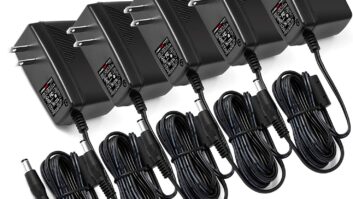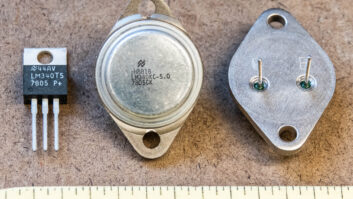Detuning unwanted reradiators
May 1, 2001 12:00 PM, By John Battison, P.E., technical editor, RF
Like mushrooms after a heavy rain, unwanted reradiators sometimes appear almost overnight in the near field of AM antennas. Legally and technically speaking, this should not happen. All construction permit applicants are required to identify AM antennas located within a certain distance from the proposed tower, and a condition that requires detuning is made a part of the subsequent construction permit. Unfortunately, this is not always done, and field strength measurements are made only after the construction. Verifying RF field distortion is not possible without preconstruction measurements.
Although cooperation and pre-construction measurements are the responsibility of the new tower owner, it is frequently a source of acrimony and litigation when the proper measurements are not performed prior to construction. For this reason, it behooves chief engineers to maintain a close watch on FCC releases and new local construction so that ignorant or uncaring operators can be contacted in time to ensure that proper procedures are followed, and the owner of the disturbing tower pays his due part of the costs.
Review on reradiation
Parasitic reradiation was discussed in the January 2001 RF Engineering column on parasitics, and it was noted that the longer the reradiator, the greater the reradiation. Visual inspection will often pinpoint the possible culprit by its location with reference to the antenna system. If in the major lobe, reradiators located farther than one mile away can sometimes cause directional pattern problems such as out-of-tolerance monitor points. When in doubt, the field strength meter is invaluable in identifying such sources. In my opinion, when problems of unexpected RF levels emerge, it is best to suspect any and all protrusions above the ground until the culprit is found.
Quite often, an out-of-tolerance monitor point is the first intimation that an engineer has of the presence of such an offending reradiator. To identify the offending reradiator, orient the field intensity meter (FIM) at a right angle to the transmitter while facing the suspected reradiator. Look for minimum direct line station pickup and maximum parasitic reradiated signal. Approach the object, and watch the meter reading. Place the vertical edge of the lid adjacent to it. A large increase in signal strength is a good indication of parasitic reradiation.
The method of detuning a reradiator depends on the electrical length of the reradiator and its location. Let’s examine coaxial line theory and see how it is applied to tower detuning.
Although the electrical effects of coaxial lines were well known prior to WWII, it took radar’s development to illuminate and exhibit the rather unusual properties of quarter-wavelength coaxial cable.
If one end of a quarter-wavelength coaxial transmission line is shorted, the other end will present an open circuit. Consider Figure 1a. Expand this idea into a quarter-wavelength antenna that has a skirt of wires hanging down from the top, as in Figure 1b. This really forms a section of coaxial cable and will resemble a folded unipole AM antenna. But instead of driving this device through the bottom of the skirt, a tuning circuit to ground provides fine adjustment to tune the array for maximum impedance at the bottom of the skirt.
This high impedance at the operating frequency places an RF electrical open circuit at the base of the tower, thus floating it at the operating frequency. Operating as an ungrounded tower, the parasite will not develop any significant voltage and will not reradiate the station’s signal to any great extent. However, it must be remembered that at frequencies other than the desired one, the tower will reradiate as before; although, any off-frequency radiation will not affect the fundamental signal.
One theoretical point to consider: assume a badly tuned directional array with a very large 10kHz sideband impedance rise. This sideband frequency may be reradiated by a tower detuned for the fundamental frequency. Audio distortion can result as the off-fundamental frequency impedance increases with a very steep impedance slope.
Detuning installation
It is customary to use three or more dropwires to form the skirt. These are suspended from cross arms placed at the top of the tower. Stand-off insulators are placed as needed down the tower to prevent shorting to it in high winds. At the lower ends, a loop of wire connects them together and is insulated from the tower and securely anchored to the ground. It is unusual for a tower to be perfectly detuned in this manner, and a parallel tuned circuit is connected to ground from the loop and is adjusted to produce very high capacitive or inductive reactance. The system is thus antiresonated, and reradiation is reduced to a minimum.
Although three dropwires are usually needed, it is sometimes possible to detune a parisitic radiator with a single dropwire. I recall a problem about thirty years ago where a police tower went up, unknown to the station, some distance away in the major lobe of a four-tower array on 1280kHz. Two monitor points were put out of limits, and eventually the new tower was suspected and �convicted.�
We dropped a single wire from the top of the tower and insulated it. We then tuned this wire for maximum current with the method described above. The two monitor points came back in. Although it worked that time, it is usually best to plan on using a minimum of three wires to be certain of adequate suppression.
Guy wires must always be handled with care. Usually, the standard breaking up of guy sections to suitable electrical lengths will be sufficient. However, sometimes it becomes necessary to use Phillystran or similar non-metallic lines for guys. Such circumstances are rare in normal installations, but it is a good idea to be aware of all possibilities when erecting antennas or towers.
Sometimes, on large self-supporting towers, individual wires placed down each side corner leg, insulated and spaced away from the tower leg down to the splayed-base supports, will work well. Although, in the case of tall towers (much more than a half-wavelength), it is usually best to build the tower in sections insulated from each other.
A tall multi-section tower would have tuning networks inserted between several insulated sections to isolate them electrically and make the tower non-reradiating.
Most engineers are familiar with the use of an RF choke in the ground line of a wooden electric supply pole to detune the vertical ground wire. We can compare this to the use and effect of a quarter-wave line. In each case, the detuning component effectively opens the RF circuit to ground and floats the tower. It is important to remember that ground wire continuity on wooden power line poles must never be broken.
The quarter-wavelength choke effect is not limited to the base end of a tower. Many times it is practical to use a quarter-wave section down from the top of a tower to detune a section, as shown in Figure 2.
As a matter of interest, ungrounded half-wave (quarter-wave plus) towers can be detuned by constructing a quarter-wave section that is grounded to the tower at the bottom. The top end of the wire skirt is left open. This effectively produces a high impedance up the tower at the open skirt and suppresses reradiation.












